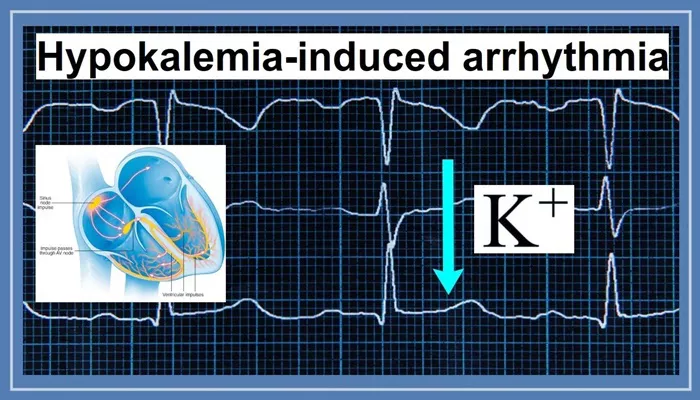Hyperkalemia is a medical condition characterized by elevated levels of potassium in the blood. Potassium is an essential electrolyte that plays a crucial role in maintaining normal cellular function, particularly in the heart. When potassium levels are too high, it can lead to serious complications, including arrhythmias—abnormal heart rhythms that can be life-threatening. For dental disease patients, understanding the link between hyperkalemia and arrhythmias is important, as cardiovascular health is closely related to overall well-being, including oral health.
How Does Hyperkalemia Cause Arrhythmia?
The heart relies on a delicate balance of electrolytes, including potassium, sodium, and calcium, to generate electrical impulses that trigger each heartbeat. Potassium plays a crucial role in repolarizing the heart muscle after each contraction, preparing it for the next beat.
When potassium levels are elevated, the following mechanisms can lead to arrhythmia:
Alteration in Resting Membrane Potential
Potassium is the primary ion responsible for maintaining the resting membrane potential of cardiac cells. When extracellular potassium levels increase, the resting membrane potential becomes less negative (closer to zero). This depolarization makes the cardiac cells more excitable and prone to premature contractions, which can lead to arrhythmias.
SEE ALSO: What Are The Characteristics of Sinus Arrhythmia?
Slowed Cardiac Conduction
Hyperkalemia can slow down the conduction of electrical impulses through the heart, particularly in the atria and ventricles. This slowing of conduction can result in a variety of arrhythmias, including bradycardia (slow heart rate), atrial fibrillation, and ventricular tachycardia. In severe cases, hyperkalemia can lead to asystole, a condition where the heart stops beating altogether.
Abnormal Repolarization
During the repolarization phase, potassium ions move out of the cardiac cells, allowing the heart muscle to relax and prepare for the next contraction. Elevated potassium levels can disrupt this process, leading to prolonged repolarization and the development of abnormal heart rhythms, such as torsades de pointes, a type of ventricular tachycardia that can be fatal if not treated promptly.
Risk Factors for Hyperkalemia in Dental Disease Patients
Dental disease patients, especially those with chronic conditions like periodontal disease, may be at increased risk of hyperkalemia due to several factors:
Medications: Some medications commonly used by dental patients, such as nonsteroidal anti-inflammatory drugs (NSAIDs) and certain antibiotics, can impair kidney function or increase potassium levels in the blood, leading to hyperkalemia.
Chronic Inflammation: Periodontal disease is associated with chronic inflammation, which can affect the entire body, including the cardiovascular system. Inflammation can lead to metabolic disturbances that increase the risk of electrolyte imbalances, including hyperkalemia.
Kidney Disease: Dental patients with advanced periodontal disease are at higher risk of developing kidney disease, which can impair the body’s ability to regulate potassium levels, increasing the risk of hyperkalemia and subsequent arrhythmias.
Symptoms of Hyperkalemia-Induced Arrhythmias
Recognizing the symptoms of hyperkalemia and the arrhythmias it can cause is critical for prompt treatment. Dental disease patients should be aware of the following signs:
Palpitations: A sensation of a fast, fluttering, or pounding heartbeat.
Chest Pain: Discomfort or pain in the chest, which may indicate a serious arrhythmia.
Fatigue: Unexplained tiredness or weakness, which can be a sign of bradycardia.
Dizziness or Fainting: Lightheadedness or loss of consciousness due to insufficient blood flow to the brain caused by arrhythmias.
Shortness of Breath: Difficulty breathing, especially during physical activity, which may be related to heart rhythm disturbances.
Preventing And Managing Hyperkalemia in Dental Disease Patients
For dental disease patients, maintaining a healthy balance of electrolytes is essential for preventing hyperkalemia and its associated risks. Here are some strategies to reduce the risk of hyperkalemia-induced arrhythmias:
Regular Monitoring
Patients with chronic dental conditions, especially those on medications that affect potassium levels, should have their potassium levels monitored regularly by their healthcare providers. Early detection of hyperkalemia can prevent the development of arrhythmias.
Medications
If a patient is at risk of hyperkalemia, their healthcare provider may adjust their medications to avoid those that increase potassium levels. In some cases, medications that lower potassium levels may be prescribed.
Dietary Adjustments
Patients at risk of hyperkalemia may need to adjust their diet to limit foods high in potassium, such as bananas, oranges, tomatoes, and potatoes. Consulting with a dietitian can help create a balanced diet that minimizes the risk of hyperkalemia.
Kidney Function
Dental disease patients should be aware of their kidney health, as impaired kidney function is a major risk factor for hyperkalemia. Regular kidney function tests and proper management of kidney disease can help prevent hyperkalemia and its complications.
Conclusion
Hyperkalemia is a serious condition that can lead to life-threatening arrhythmias by disrupting the heart’s electrical activity. Dental disease patients, particularly those with chronic conditions like periodontal disease, are at increased risk of hyperkalemia due to factors such as medications, inflammation, and kidney disease. Understanding the link between hyperkalemia and arrhythmias is essential for preventing complications and maintaining overall health.


